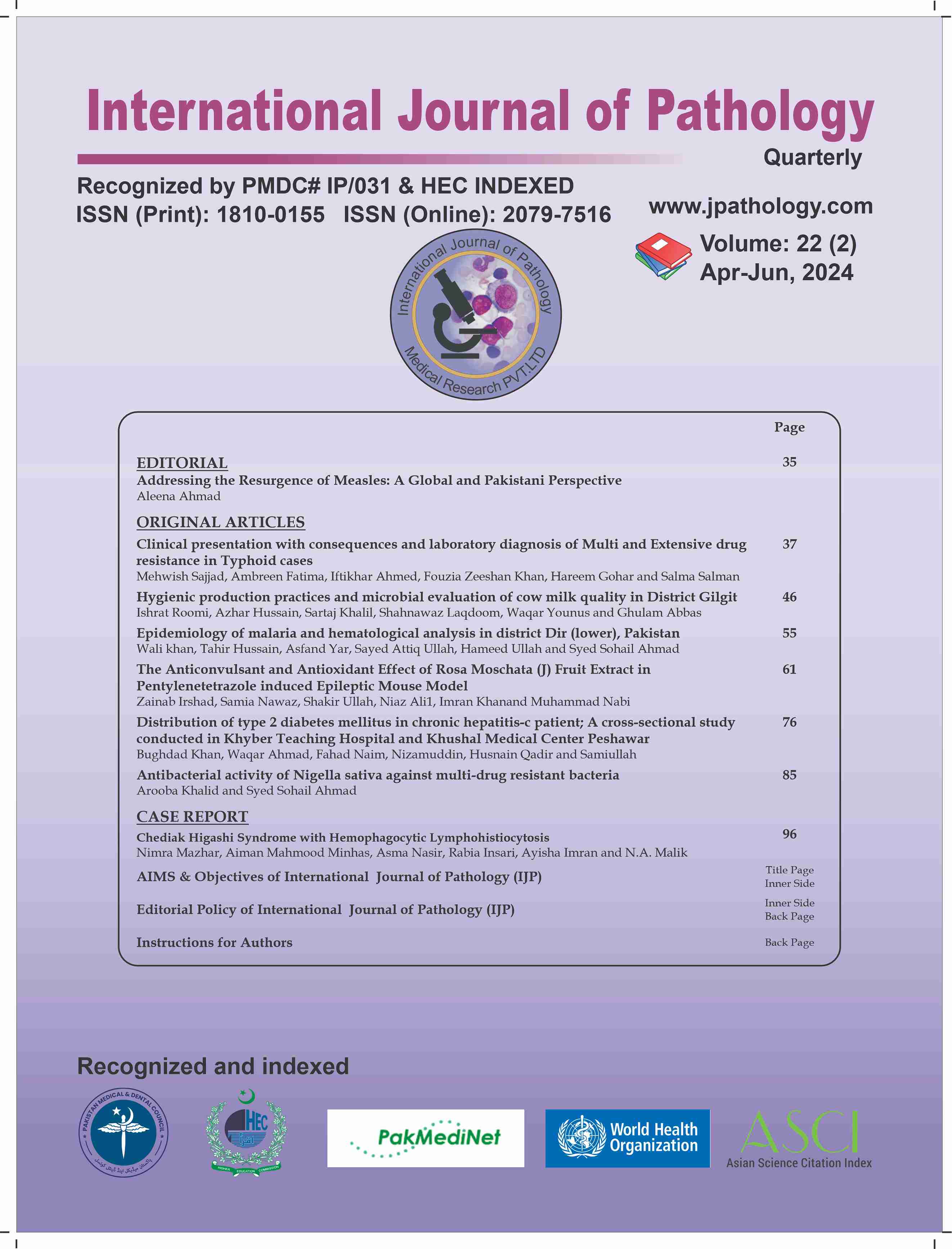Epidemiology of malaria and hematological analysis in district Dir (lower), Pakistan
DOI:
https://doi.org/10.59736/IJP.22.02.898Keywords:
hemoglobin, rbc, malariaAbstract
Background: Malaria is considered as a tropical disease, in developing countries. Among all parasitic infections malaria is most widespread and devastating disease. According to WHO malaria is endemic in 24 countries. Methods: This cross-sectional study was conducted at Department of Medical Laboratory Technology University of Haripur. Total 995 samples were collected at District Head Quarter Hospital (DHQ), Tehsils Hospitals (THQs), and other private laboratories in District Dir (Lower). These samples were processed to observe the shape of RBCs as well as plasmodium species in the smear microscopically, and for hemoglobin estimation. Data was analyzed through SPSS version-21. Results: Highest percentage of malaria was recorded in Munda (35.17%) followed by Timergara (19.59%) whereas the lowest number of cases were found in Khall (5.02%). Prevalence of P. vivax was (98.0 %) and P. falciparum was (2 %) in district Dir Lower. Mean red blood cell count (RBCs) was 4.2±0.64 mm3 while mean Hb was 11.0±1.99g/dl. Based on different age categories, the highest RBCs and Hb levels were found in age group 41-50 years, whereas the lowest RBCs were found in age group 11-20 years while the lowest Hb levels were recorded in group 1-10 years. In associated diseases, the upper respiratory tract infections (URTIs) were the most frequent (20%) followed by diarrhea (18%). Mean Hb of males was 11.8±1.53 g/dl while the mean Hb of female was 11.5±5.384 g/dl. Hb in both males and females were low as compared to the standard. However, as compared to females, Hb of males were significantly lower with p-value <0.001. Conclusion: We concluded that males are more commonly infected from malaria as compared to females. Males and children were found to have low Hb as compared to females and higher age group patients. URTIs and diarrhea were the most common associated illness.
References
Hussain A, Ahmad T, Jamal SG. Prevalence of Human Malaria Infection in Lal Qilla Pakistan. American Journal of Biomedical Sciences. 2015;7(1).
Bhatia R, Rastogi RM, Ortega L. Malaria successes and challenges in Asia. Journal of vector borne diseases. 2013;50(4):239-47.
D'Souza BJ, Newman RD. Strengthening the policy setting process for global malaria control and elimination. Malaria Journal. 2012;11:1-3.
Abuaku BK, Koram KA, Binka FN. Antimalarial drug use among caregivers in Ghana. African Health Sciences. 2004;4(3):171-7.
Salma Shaikh SS, Hafeezullah Memon HM, Amna Shaikh AS, Imran Ahmed IA, Bhagchand Iohano BI, Baird K. Severe disease in children hospitalized with a diagnosis of plasmodium vivax in south-eastern Pakistan. 2012.
Patel A, Jain S, Patel B, Modi B. Hematological changes in P. falciparum & P. vivax malaria. National journal of medical research. 2013;3(02):130-3.
Haroon H, Fazel PA, Naeem M, Mobin A, Naqvi AH, Makki K. Hide and seek: hematological aspects of malaria–a developing country perspective. The Journal of Infection in Developing Countries. 2013;7(03):273-9.
Irshad M, Ali R, Akbar S, Muhammad AT. Occurrence of malaria in Khwazakhela District Swat Pakistan. PSCI publ. 2013;2:26-8.
Ahmad T. Plasmodium vivax and Plasmodium falciparum are common malaria species in Pakistan. Biomedical Research and Therapy. 2016;3(6):26.
Farzinnia B, Saghafipour A, Abai M. Malaria situation and anopheline mosquitoes in Qom province, central Iran. Iranian Journal of Arthropod-Borne Diseases. 2010;4(2):61.
Shah H, Khan R, Naz F, Haseeb A, Jan A, Ullah R. Prevalence and distribution of malaria parasites in general population of district Dir Lower, Khyber Pakhtunkhwa, Pakistan. J Entomol Zool Studies. 2016;4(4):1211-15.
Doulat B, Bikha D, Akbar Y, Syed S, Tarachand D, Ishrat B. Frequency and pattern of herpes zoster at Liaquat University Hospital Hyderabad [six months hospital based descriptive study]. 2009.
Ansar Mahmood M, Nusrat Z, Nadir A, Aminah Mahmood M, Rubina K. Haematological findings and endemicity of malaria in Gadap region. 2010.
Ahmad T, Hussain A, Ahmad S. Epidemiology of malaria in Lal Qilla. International journal of scientific and technology research. 2013;2(11):199-202.
Downloads
Published
Issue
Section
License
Copyright (c) 2024 Wali Khan, Tahir Hussain, Asfand Yar, Sayed Attiq Ullah, Hameed Ullah, Syed Sohail Ahmad

This work is licensed under a Creative Commons Attribution-NonCommercial 4.0 International License.
Readers may “Share-copy and redistribute the material in any medium or format” and “Adapt-remix, transform, and build upon the material”. The readers must give appropriate credit to the source of the material and indicate if changes were made to the material. Readers may not use the material for commercial purpose. The readers may not apply legal terms or technological measures that legally restrict others from doing anything the license permits.


